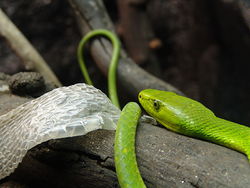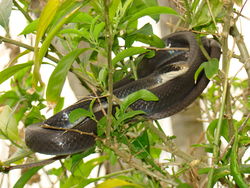Snake Housing
Introduction to housing
Captive husbandry of snakes presents several basic problems. The biology of most free-living snakes has not been recorded and it may be impossible to match nature in a captive situation. Improper husbandry is the most important cause of disease in snakes since it compromises a snake's immune system and leads to opportunistic infections. Important aspects of snake husbandry include the cage environment, nutrition and water.
Housing Considerations
Considerations for cages include size, shape, security, ease of cleaning, ease of access and positioning.
- Cage size is related to size and species. As snakes grow they need larger cages. Neonates can be kept in relatively small containers but adequate ventilation is necessary. Obesity is a problem in large captive snakes and for this reason they should be provided ample space within an enclosure for physical activity.
- Arboreal species require high cages with a three dimensional climbing area while floor area is important for terrestrial species.
- Security is of major importance. Cages that are sealed along their seams and have doors or lids that close simply and securely are essential.
- Cages should be able to be easily cleaned since they are continually being contaminated with faeces. Cages that can be steam-cleaned are advisable for the larger species.
- Doors or lids need to be simple and give adequate access.
- Ideally cages should be placed against an interior wall and out of direct sunlight.
Temperature
All snakes are ectothermic and each species has a preferred optimum temperature zone (POTZ). The ambient cage temperature should be at the lower end of a POTZ. The cage should also have a "hotspot" at the upper end of the POTZ so that a temperature gradient is established. This is essential since it allows a snake to choose the temperature appropriate for its present metabolic state. A night temperature drop of about 5°C is adequate.
- Sick reptiles tend to seek the area in the cage that is towards the high end of their POTZ.
- Snakes kept at suboptimal temperatures often regurgitate their food.
- For more information, see Snake Feeding and Digestion.
Heating
The primary heat source can be central heating, heat tapes or pads, or radiant heat. A secondary heat source for a "hotspot" is then positioned at one end of the cage. Lights should not be used as heat sources since this will interfere with the photoperiod.
- Snakes should not be able to come in contact with any bulbs, and hot rocks are not recommended because of the possibility of burns.
- For more information on burns, see Snake Vesicular Dermatitis.
- Monitoring of both maximum and minimum temperatures is essential and thermometers should be positioned in the cooler area and the basking area. Thermostats are useful to allow more accurate control of temperatures.
Lighting
Lighting requirements for captive snakes are ill-defined. Snakes satisfy their vitamin D3 requirements from their diet but many species benefit from access to unfiltered sunlight (while still remaining withing their POTZ). The length of photoperiod may be important for temperate species which require timers for the lighting.
| Species | Summer (hrs) | Winter (hrs) | Spring/Autumn (hrs) |
|---|---|---|---|
| Tropical | 13 | 11 | 12 |
| Temperate | 15 | 9 | 12 |
Full-spectrum bulbs are sold with a numeric designation. 5.0 bulbs appear sufficient to stimulate the necessary previtamin D synthesis in lizards and are also considered sufficient for snakes. Bulbs should be placed no further than 18 inches from the animal to ensure maximum UVB exposure. Glass refracts UVB radiation which makes glass lids an inappropriate housing feature. Full-spectrum bulbs usually have an 8 to 14 month activity period.
Substrate
The substrate should be simple to allow easy cleaning. Newspaper is perhaps the best substrate as it is disposable, cheap and can be used for the majority of species. Other commonly used substrates include carpet, Astroturf, pine and ash wood shavings. Shavings of woods such as cedar, which are high in aromatic compounds, should be avoided because they are toxic. Items that can be ingested such as small stones, gravel and corn cob bedding, should also be avoided. Peat and gravel look attractive but hide urates and faeces. Fossorial (burrowing) species such as sand boas require a substrate (such as sand) in which they can burrow. Leaf litter is also a good alternative. Imported materials should be inspected closely to avoid the introduction of unwanted pests, such as insects.
Humidity

A relative humiditiy of 50-70% is adequate for most species but some species have more specific requirements. Desert species require 20-30% while a higher humidity is required for rainforest species (for example the emerald tree boa). The humidity can be increased by spraying the environment and by adding water-retaining substances such as moss, peat or vermiculite.
Inadequate humidity (for example excessive air conditioning) leads to stress, dehydration and dysecdysis. Excessive humidity (such as inadequate cage ventilation) leads to skin infections. A humidity chamber (a container filled with damp tissue paper) can be provided for ecdysis. The problems associated with low humidity can sometimes be overcome by daily water baths for 1-2 hours.
- Observation of shedding is a good way to judge the humidity since snakes should shed in one piece if the humidity is adequate.
- Excessive humidity is frequently associated with dermatitis.
- For more information on snake shedding, see Snake Shedding.
- Snake mites, dysecdysis, blister disease and retained spectacles are all influenced by humidity.
Water
Clean fresh water in a bowl large enough to permit immersion/bathing should be available at all times and is essential for ecdydsis (and to prevent dysecdysis). At a mimimum the water should be changed and the bowl cleaned daily and preferably after the snake soaks. The feeding area should not be adjacent to the water. Some species require drip systems and spraying to accept water. Many pit vipers will not drink from containers and emerald tree boas prefer to drink when water collects in their body coils following spraying.
Aquatic and semiaquatic species require special attention and water quality control is essential. Ideally a filtration mechanism prevents the water from becoming stagnant. Undergravel and sand filters should be used in addition to external filters. Commercially available salts for marine fish tanks can be used for sea snakes and other marine snakes.
Branches
Arboreal species require branches in a high tank to reflect their free-living environment. These branches must be strong enough to support the weight of the snakes and be securely propped to prevent accidents. Only non-resinous oak, fruit or other hardwoods should be used.
Visual security
Cage furniture should be kept to a minimum but a hiding place is essential. Terrestrial snakes prefer to crawl into small holes or crevices when at rest, and many will not feed if a hiding area is not provided. Silk trees or plants can offer visual security and require minimal maintenance. They help to augment the relative humidity if frequently misted and aid in a snake's ability to camoflage itself.
| Snake Housing Learning Resources | |
|---|---|
 Full text articles available from CAB Abstract (CABI log in required) |
Hot or cold: the use of thermography in reptile husbandry and management. Fleming, G. J.; The North American Veterinary Conference, Gainesville, USA, Small animal and exotics. Proceedings of the North American Veterinary Conference, Orlando, Florida, USA, 17-21 January, 2009, 2009, pp 1781-1782, 13 ref. |
| This article has been peer reviewed but is awaiting expert review. If you would like to help with this, please see more information about expert reviewing. |
Error in widget FBRecommend: unable to write file /var/www/wikivet.net/extensions/Widgets/compiled_templates/wrt662c0bcfe80044_54543825 Error in widget google+: unable to write file /var/www/wikivet.net/extensions/Widgets/compiled_templates/wrt662c0bcfeb2fe8_39530554 Error in widget TwitterTweet: unable to write file /var/www/wikivet.net/extensions/Widgets/compiled_templates/wrt662c0bcfee0eb9_77049726
|
| WikiVet® Introduction - Help WikiVet - Report a Problem |
